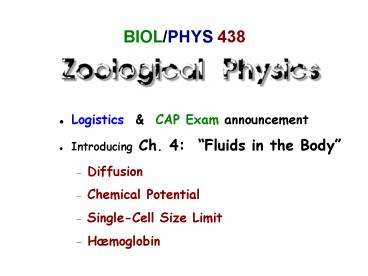BIOLPHYS 438 - PowerPoint PPT Presentation
1 / 13
Title: BIOLPHYS 438
1
BIOL/PHYS 438
- Logistics CAP Exam announcement
- Introducing Ch. 4 Fluids in the Body
- Diffusion
- Chemical Potential
- Single-Cell Size Limit
- Hæmoglobin
2
Logistics
Assignment 1 login, update, Email
anytime! Assignment 2 due Tuesday Assignment
3 Tuesday ? Thursday 15 Feb Assignment 4
Thu 15 Feb ? Tue after Break Spring Break
17-25 Feb work on Project too!
3
More Logistics
- People Database
- Please log in, Update your Profile (especially
your Email address!) and participate. - Few received my Email notice about the fabulous
Harvard video on cellular nanoprocesses. -( - Projects
- Draft proposals due today!
- How about a Web Database of Project Ideas? (like
the Quips database anyone can contribute)
4
Conduction of Heat
HOT side (TH)
Q cond ? A (TH - TC) / l
l
Thermal conductivity W m-1 K-1
COLD side (TC)
For an infinitesimal region in a thermal
gradient, J U ? T
?
5
Diffusion
High Concentration side (n0 dn) m-3
N diff D A dn / dx
dx
Diffusion Constant m2 s-1 (or Diffusivity)
Low Concentration side (n0) m-3
For an infinitesimal region in a concentration
gradient, J N D n (Fick's First
Law)
?
6
Chemical Potential
A little more Statistical Mechanics we have
defined temperature ? by 1/? ds/dU where
U is the internal energy of the system and s
is its entropy. By similar logic we can define
the system's chemical potential m by m / ?
- ds/dN where N is the number of particles of a
given type that it contains. (There is a
different m for each type of particle.) Like t,
the chemical potential m has units of energy J.
Entropy increases when particles move from a
region of high m into a region of low m ... so
they do!
7
Using the Chemical Potential
m - ? ds/dN is used like a potential energy
J in that particles tend to move downhill
from high m to low m. For ideal gases (and even
for concentrations of solutes in water!) we have
mIG ? log(n /nQ) where nQ is a constant.
In thermal equilibrium, we require mtot mIG
mext constant, where mext is some external
potential energy per molecule, like mgh or the
binding energy of an O2 molecule to
hæmoglobin. Example 100 humidity at roots vs.
90 at leaves will raise H2O molecules 1.5 km!
(but only as vapor)
8
Osmosis
Little molecules (like H2O) can get through the
screen but big solute molecules can't. If the
solute likes to be dissolved in water, it will
create a chemical potential to draw H2O molecules
through the membrane, creating an effective
osmotic pressure.
(image from Wikipedia)
9
Osmotic Diffusion
High Concentration side (n0 dn) m-3
N water - Dw A dn / dx
dx
Diffusion Constant m2 s-1 (or Diffusivity)
of water
H2O
Low Concentration side (n0) m-3
For an infinitesimal region in a concentration
gradient, J water - Dw nsolute
(Fick's First Law)
?
10
Cell Wall
Courtesy of Myer Bloom CIAR Program on Soft
Surfaces
11
Model of a Single Cell
O2 in H2O
Ndiff D A dn / dr where A 4? r 2
and D 1.8 ? 10-9 m2 s-1 Diffusivity of O2
in H2O. If nw 0.03 nair 1.62 ? 1023 m-3
Concentration of O2 in H2O and we assume that n
decreases steadily to zero at r 0, then dn /
dr nw / r, giving Ndiff 3.66 ? 1015 r,
so the specific supply s Ndiff /M 0.88 ?
1012 r -2, in SI units.
r
M (4? /3) r r 3
Meanwhile, the specific demand of d
Nreq /M comes to d 2.21 ? 1018 b ?0 /M 0.88
? 1017 M -1/4/bs . Since M increases as r
3, d decreases as r -3/4. The supply
decreases faster than the demand, so eventually
if a cell gets too big, it cannot get enough
oxygen via diffusion alone.
CO2 in H2O
12
Lungs Alveoli
13
Hæmoglobin
m - ? ds/dN is like a potential energy J
oxygen molecules tend to move downhill from
high m to low m. For concentrations of solutes
in water we have mIG ? log(n /nQ) where nQ
is a constant. In thermal equilibrium, we
require mtot mIG mext constant, where
mext is the binding energy of an O2 molecule to
hæmoglobin (Hb). The stronger the binding, the
more downhill! The density n is proportional
to the partial pressure p. Oxygen occupies all
Hb sites for p gt 10 kPa (0.1 atm) and is
released when p lt 2 kPa (0.02 atm). What
happens when CO competes with O2 for Hb?































